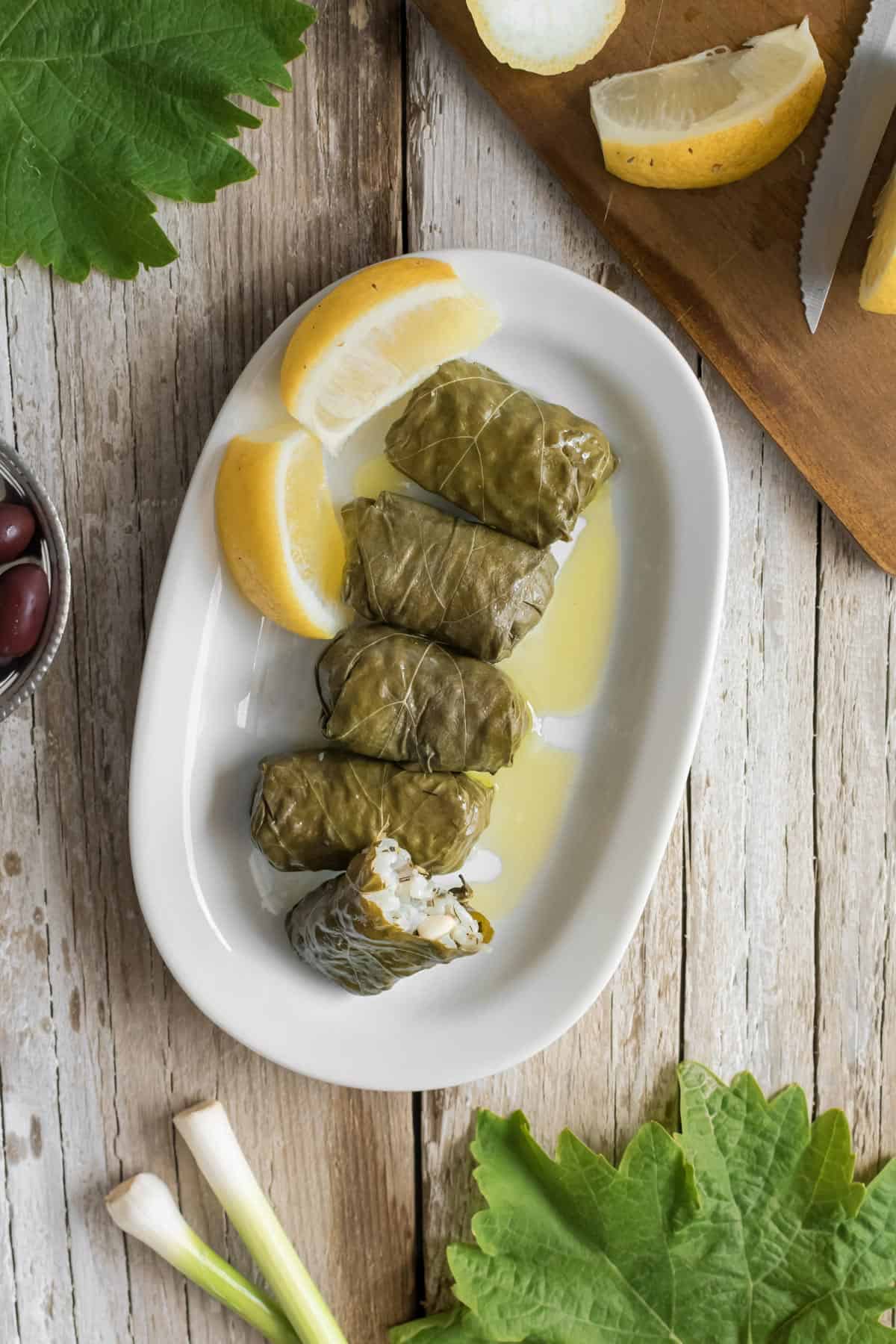
Greek Stuffed Vine Leaves is one of the highlights of Greek cuisine. A unique dish, with a very distinctive flavor. Vine leaves (grape leaves) are stuffed with rice, fresh herbs, and pine nut filling.
Sometimes vine leaves are stuffed with ground meat also like lamb or beef. In Greek, we call them Dolmadakia. Dolmadakia we name the small Dolmades.
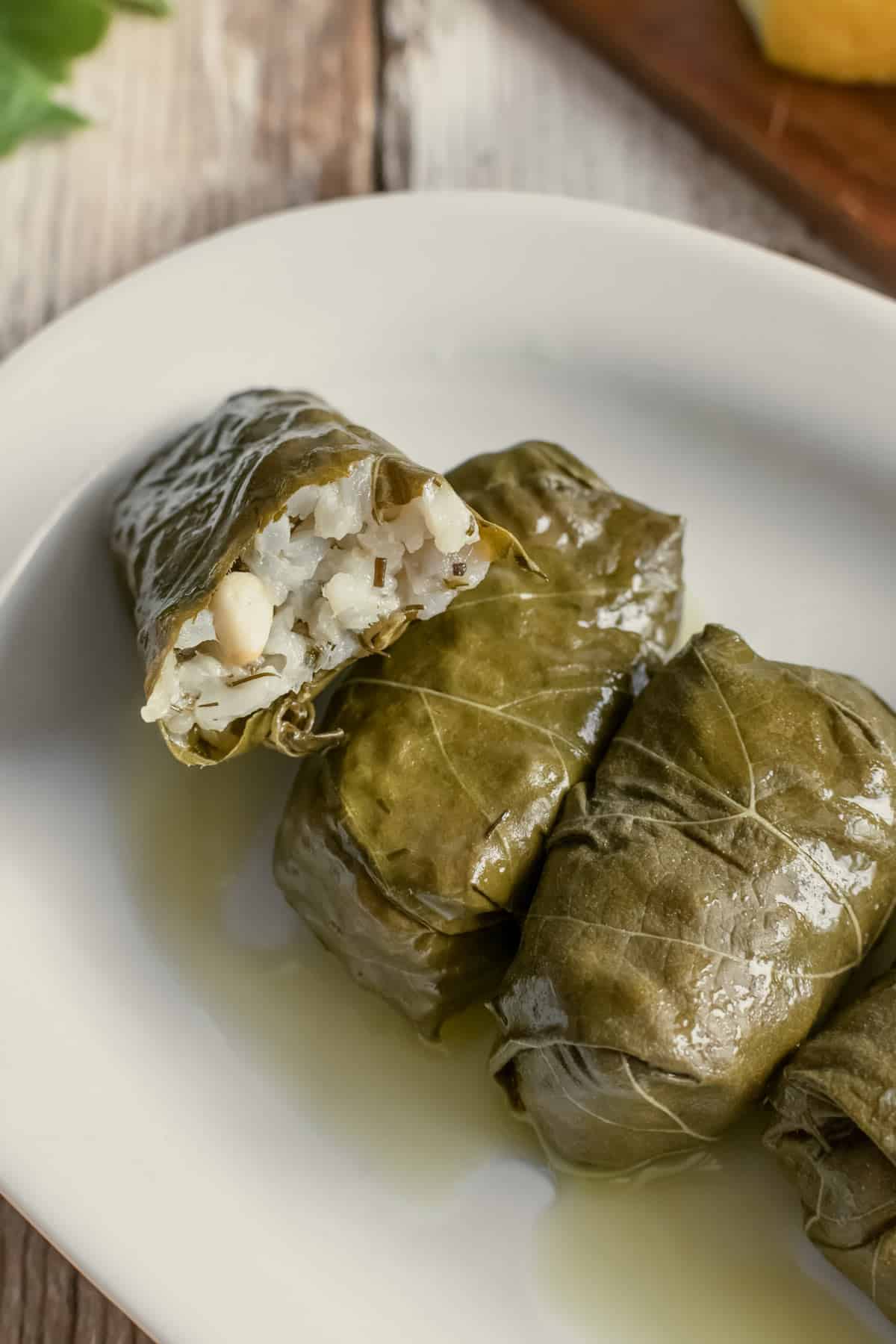
But What Are Dolmades?
Dolmades refers to a stuffed leaf. Whether it’s stuffed grape leaves or stuffed cabbage leaves (like in Lahanodolmades).
Where To Find The Vine Leaves (Grape Leaves)
Traditionally, vine leaves are collected in early spring when the vine starts to grow its new and tender leaves. Fresh leaves are then blanched in a boiling water that contains either white wine or vinegar before they can be used.
If you can’t find fresh leaves though, you can get them preserved in jars with brine that are ready to use.
And to tell you the truth, in today’s world, most people prefer to use the preserved vine leaves. As long as you can find a good quality because sometimes you get leaves that are really old, hard and chewy.
Try a Greek market or you can buy them online in case you can’t find them in your area.
I’m going to share two labels with you here that are both Greek and of a good quality.
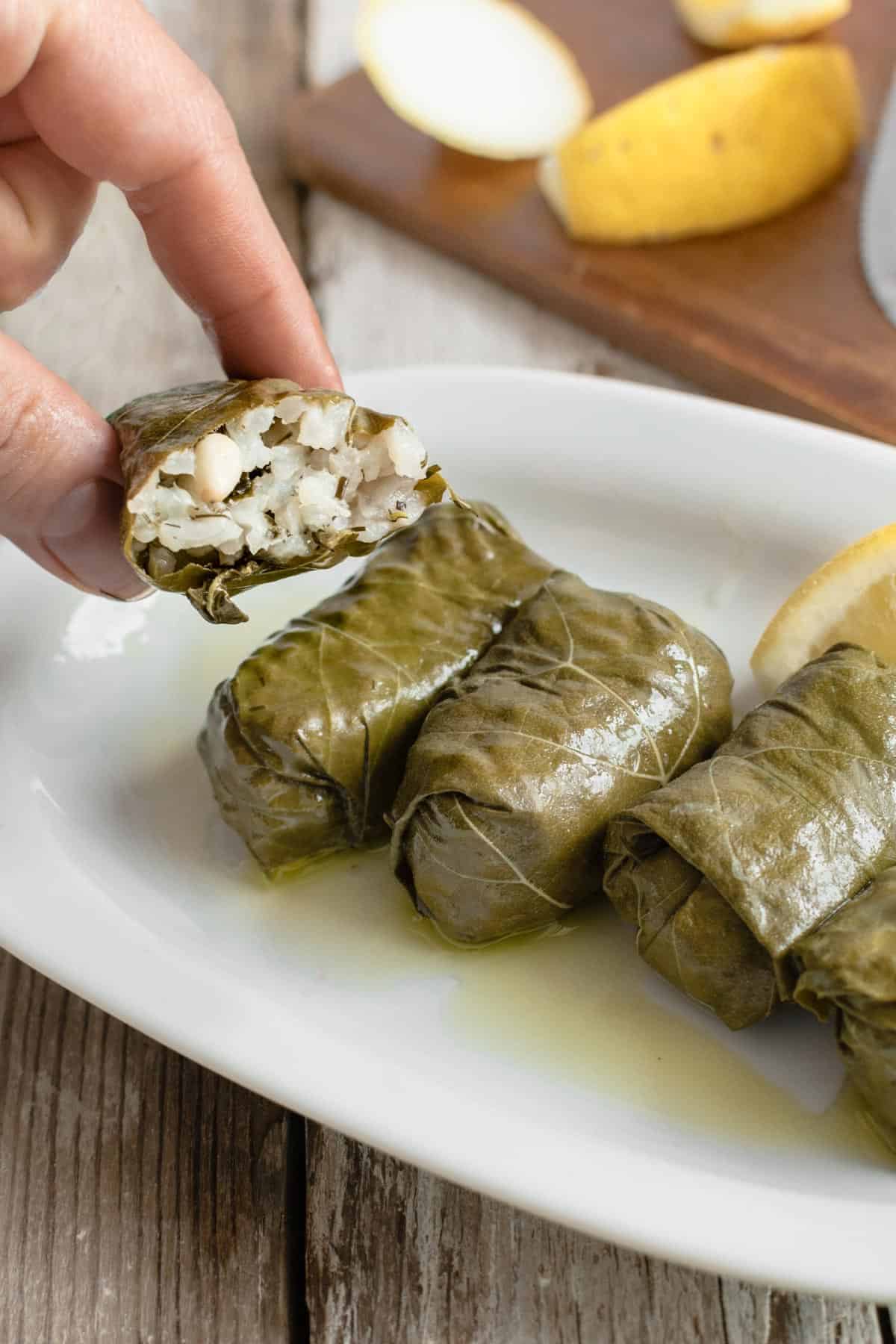
Are Grape Leaves Healthy?
Oh, yes you can definitely say they are! Since they're rich in fiber which is what usually lacks from our diet these days (about 11 grams of fiber in every 100 grams of grape leaves). They're also very rich in vitamin A (440% of the recommended daily intake in every 100 grams of grape leaves). They're also a good source of Calcium, Magnesium, and vitamin B-6.
How To Make Stuffed Vine Leaves
The only thing you may find a bit intimidating the first time you will make Dolmades is folding and wrapping them. But it only takes a bit of practice until you get the hang of it. Then you will want to make them again and again.
STEP 1 → Prepare the leaves
If you use fresh leaves, first clean them well. Soak in plenty of water with 1-2 tablespoons vinegar for 5-10 minutes. Then fill a pot with water and add 2-3 tablespoons of red wine vinegar or white wine instead. Bring to a boil and blanch the leaves. Do this by dipping the leaves in the hot water for 2 minutes and then transfer in a bowl with cold water right away. Once cooled transfer in a strainer.
If using store-bought leaves preserved in brine, simply place them in a strainer to drain before using.
STEP 2 → Prepare the filling
You have to cook the filling in a pan before you add it in the dolmades. This is done because rice doubles in size when cooked and if you add it uncooked inside the dolmades it will burst out of them.
So to make the filling you need to saute and caramelize the onions and garlic in hot olive oil. Then stir in the rice and vinegar. Add the water and cook until rice is completely cooked and very soft. Stir in the fresh greens and set them aside to cool down before you start the wrapping.
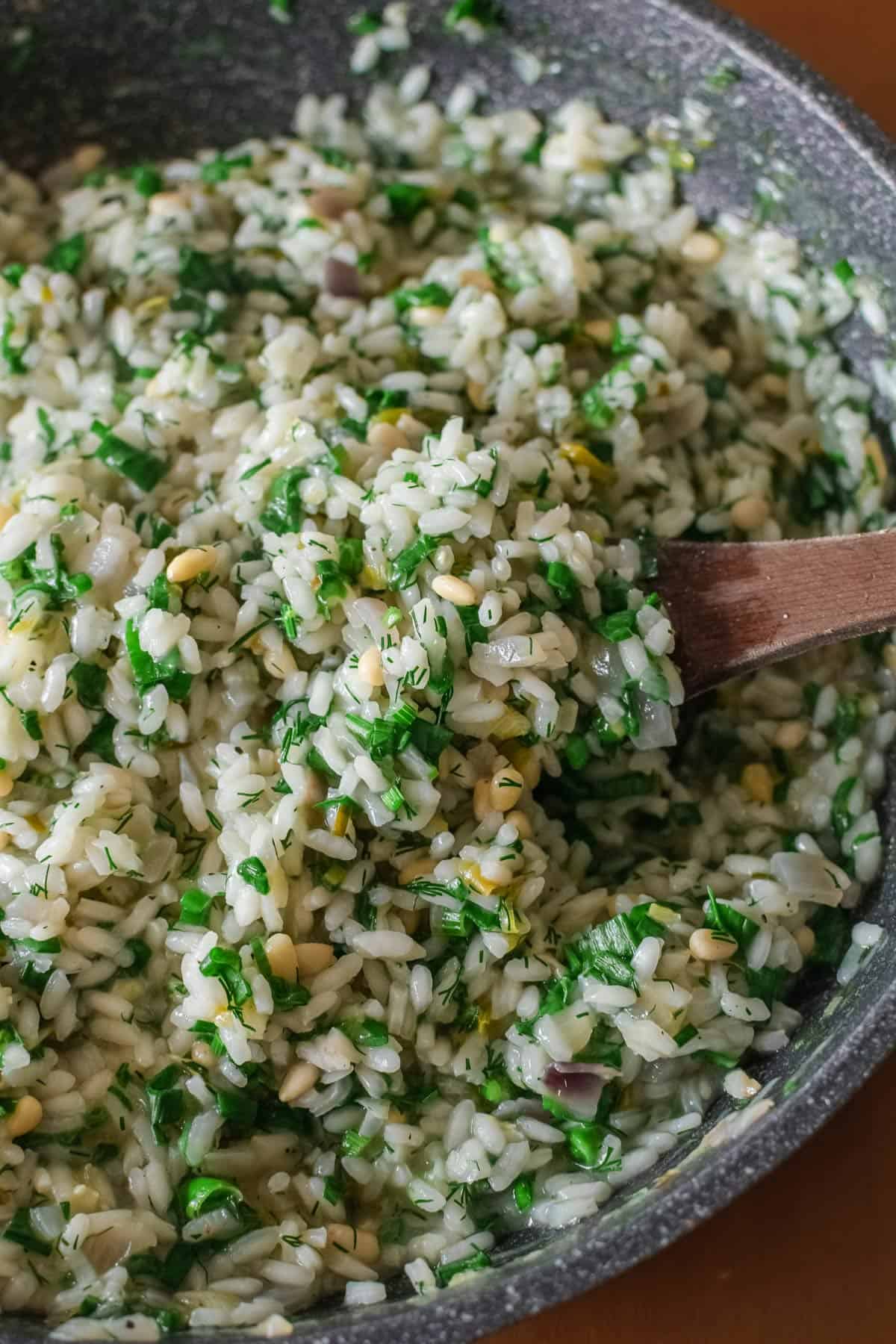
QUICK TIPS:
- Use quality short grain rice to help you roll them nicely. It will be sticky and keep nice and soft just like in sushi.
- Add the green parts of the spring onions right at the end (together with the herbs) to give a nice freshness and extra flavor to the filling.
STEP 3 → Start the wrapping
Now because one picture is a thousand words, I've included a picture tutorial below to show you how the wrapping and rolling are done. Which is pretty basic stuff really. There are only two things you need to pay attention to:
One is, to place the grape leaf with its downside facing upwards so once you roll it, its smooth side will be on top. And two, pay attention to the filling you add to each dolma. If the leaf is big enough you may add a whole tablespoon of the filling. If the leaf is smaller, add ⅔ or half a tablespoon of the filling.
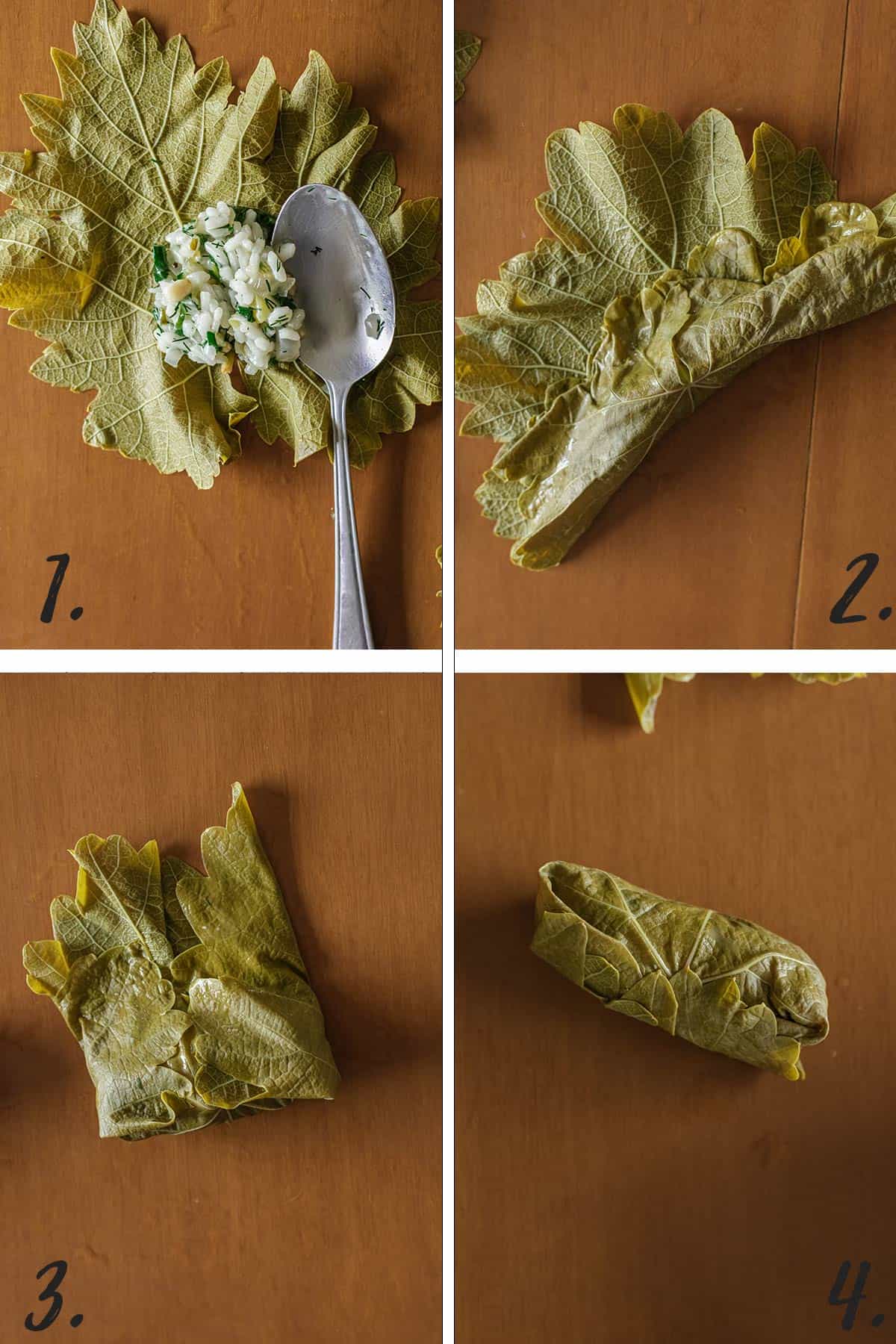
- Lay a grape leaf on a flat working surface and add some of the filling in the center bottom of the leaf.
- Overlap the bottom end of the leaf over the filling. Press gently to remove air and stick together.
- Fold the right and left sides inwards.
- Roll nice and a bit tight to form a Dolma.
Cover the bottom of a cooking pot with a few grape leaves (to prevent Dolmadakia from scorching at the bottom).
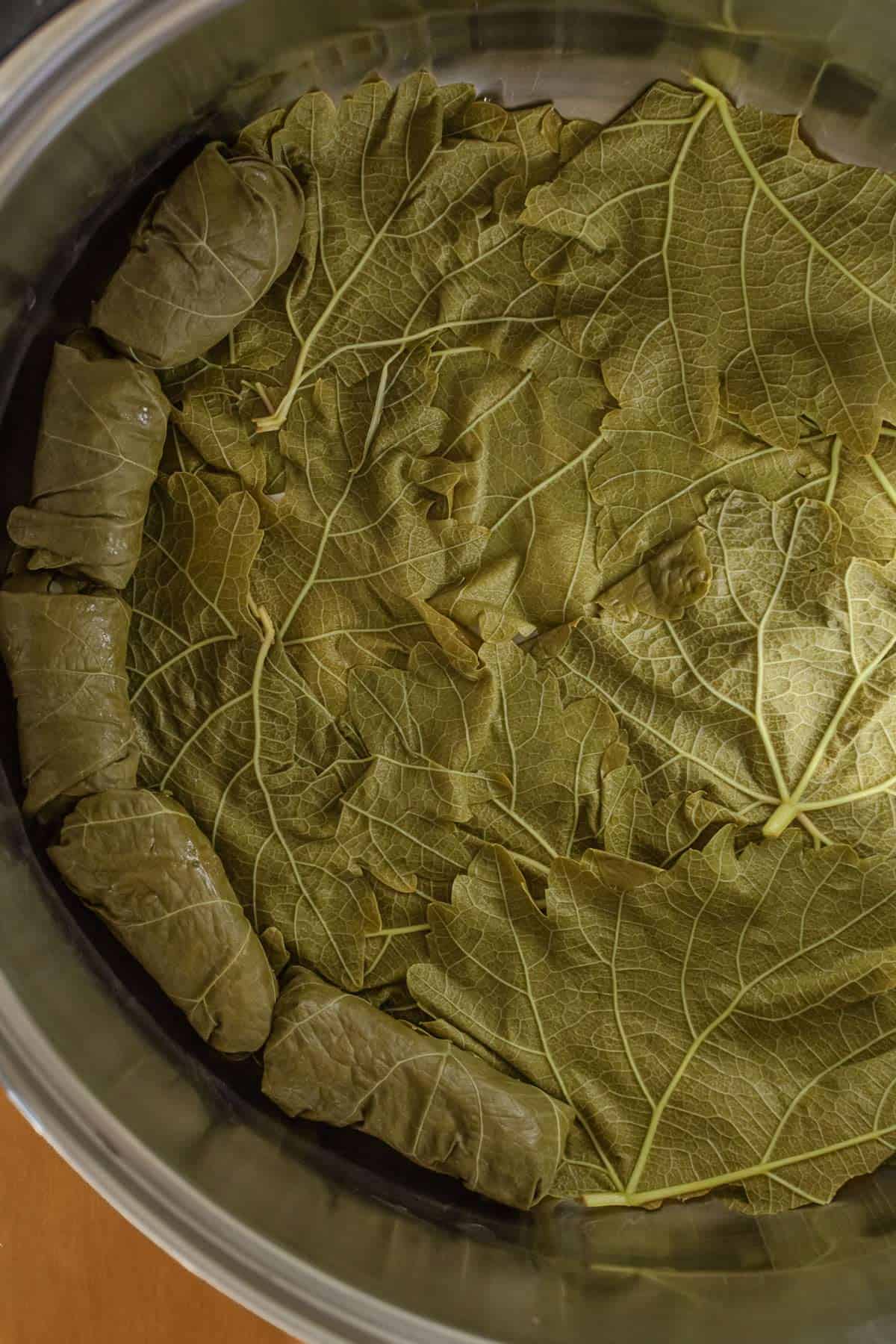
Place Dolmadakia close to each other in the pot so they won't unroll while cooking. With folded end at the bottom.
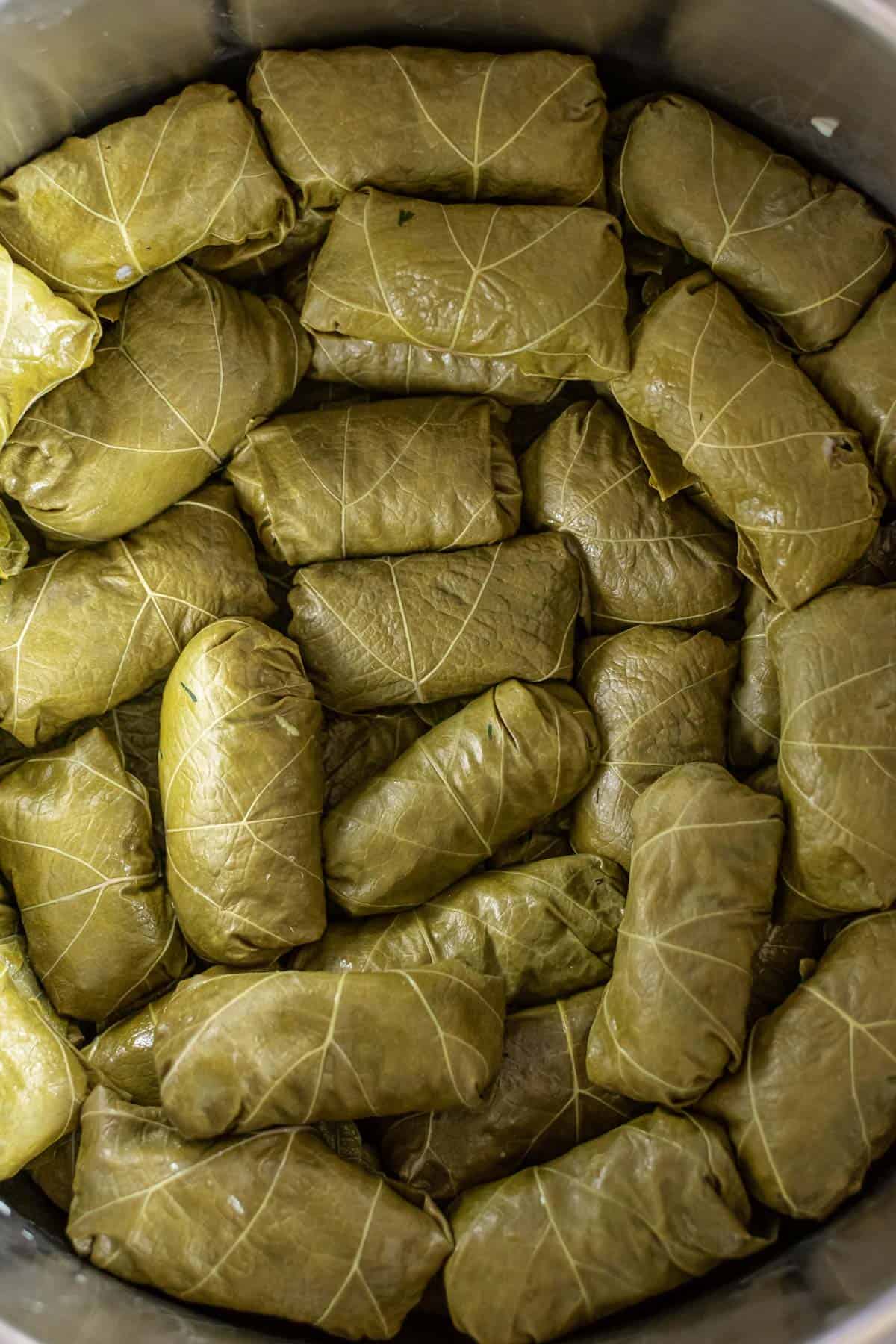
Add a plate on top of them to weigh them down. The olive oil and water and simmer over medium-low heat partly covered. Don't let the water bubble too hard and boil because they will unroll. After 45 to 50 minutes add the lemon juice, remove from heat and let them stand for a few minutes before serving them.
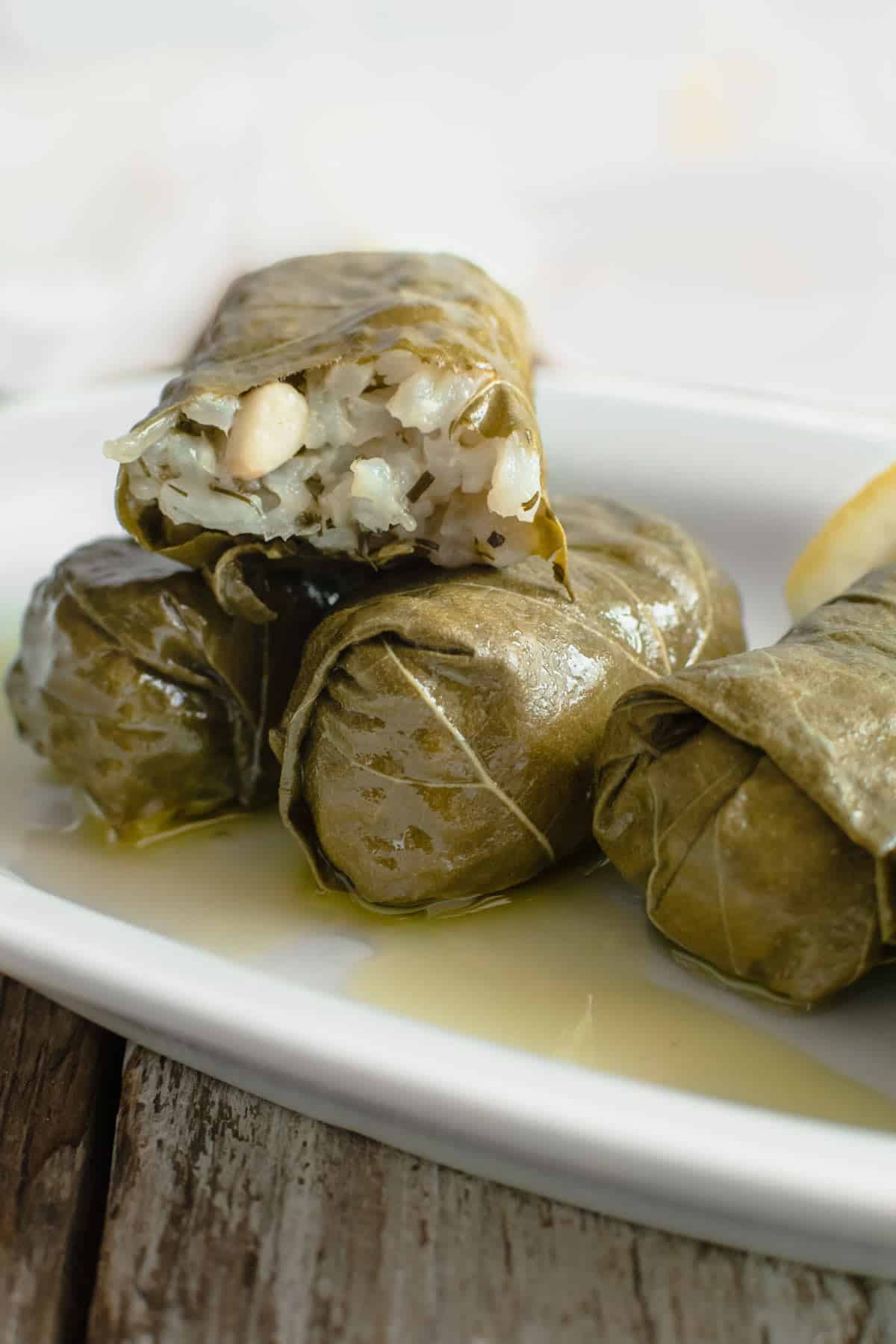
Keep the leftovers in a food container in the fridge for 3-4 days. Personally, I like them even better cold from the fridge. I can eat tons of them like that. And did you know that they're even healthier this way? When rice gets cooled it turns into resistant starch which is a really healthy fiber for your tummy. But enough with the healthy stuff, wishing you a fun time with the rolling and do enjoy them any way you like best!
YOU MAY ALSO LIKE:
- Greek Spinach Rice With Lemon (Vegan, Gluten-Free)
- Greek Potato Salad With Garlic Lemon & Fresh Herbs (Vegan, Gluten-Free)
- Rice Stuffed Vegetables - Yemista (Vegan, Gluten-Free)
Recipe
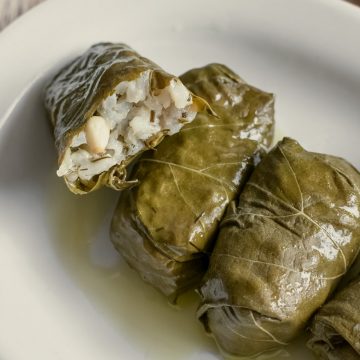
Greek Stuffed Vine Leaves -Dolmadakia
Ingredients
For The Filling:
- 1 medium-sized red onion minced
- 3 small spring onions
- 2 sticks of fresh garlic or 3 garlic cloves
- 300 grams / 10.5 oz short-grain rice Karolina rice
- 3 tablespoons red wine vinegar
- 3 tablespoons fresh dill finely chopped
- 2 tablespoons fresh parsley finely chopped
- 30 grams / 1 oz pine nuts
- 1 lemon zested and juiced
For The Dolmadakia:
- 450 grams / 15.8 oz vine leaves in brine or about 50 fresh leaves
- 10 tablespoons virgin olive oil +an extra splash for sauteeing
- 1 lemon juiced
- freshly ground pepper and kosher salt
- red wine vinegar to use for washing and preparing the leaves
Instructions
Prepare The Leaves:
- If using grape leaves preserved in brine, place them in a strainer to drain.
- If using fresh leaves, let them soak in plenty of water along with 1-2 tablespoons of red wine vinegar. Then transfer in a strainer to drain.
- Fill a cooking pot with plenty of water and bring to a boil. Add 2-3 tablespoons red wine vinegar or white wine instead. Add the leaves to the pot and cook for 2 minutes from the moment the water starts to boil again. Then transfer in a large bowl or pot filled with very cold water and let them cool completely. Transfer leaves in a strainer.
- NOTE: When you place the leaves in the strainer, add them flat open stacked on top of each other. So they won't tear when you take them out later on.
Make The Filling:
- Separate the green parts from the spring onions and fresh garlic. Finely chop both but keep them separately. The white parts will be sauteed while the green parts will be added right at the end along with the fresh dill and parsley. This way you add a great boost of flavor and freshness to the filling.
- Heat a good splash of olive oil in a non-stick pan over high heat. Add the red onion, and cook for a minute until it softens slightly. Reduce heat to medium-high. Add the white parts of the spring onions and fresh garlic (or garlic cloves instead). Season with salt and pepper. Cook until completely soft and caramelized (2-3 minutes).
- Add the rice and cook for a minute stirring constantly with a wooden spoon. Add the 3 tablespoons of red wine vinegar and stir well. Pour in 750 ml of hot water and once it starts to boil, reduce heat to medium-low and simmer rice until it absorbs all of the water and becomes completely soft and tender.
- Remove from heat and stir in the pine nuts, parsley, dill, greens parts of spring onions and garlic, as well as the juice of one lemon and the zest of one lemon. Set aside to cool before start rolling the leaves.
- Lay a few leaves in the bottom of a medium-sized cooking pot in order to cover its bottom.
- Take a grape leaf and place it on your working surface so its wrong side is facing upwards. Depending on the size of the leaf, add either a full tablespoon, ⅔ of a tablespoon, or half a tablespoon of the filling to the bottom center of the leaf. The filling inside the dolma should be enough to give it shape but without it looking like it's about to explode. After rolling a few you will get the hang of it and adjust the filling accordingly. For a leaf that's about 12 cm / 5-inch long, you can add a whole tablespoon. Not too loaded though.
- Once you placed the filling on the grape leaf, overlap its bottom over the filling and press gently to stick together and form a roll. Then tuck the sides inwards and start rolling towards the other end.
- Place the dolma in the pot with the seam side down. Continue the rolling until you finished all the leaves and the filling. Make sure you place the dolma in the pot tightly close to each other so they won't unroll while cooking.
- Add a plate on top of the dolmas to secure them in place. Then pour 500 ml hot water and 10 tablespoons olive oil in the pot. Cook over medium-low heat partly covered for about 45 to 50 minutes from the moment the water starts to simmer inside the pot.
- Then remove the pot from heat and set it aside to cool for about 30 minutes. Carefully remove the plate and pour in the lemon juice. You can eat them both warm and cold. Leftovers can be stored in a food container in the fridge for up to 3-4 days.
Nutrition
YOU MAY ALSO LIKE...

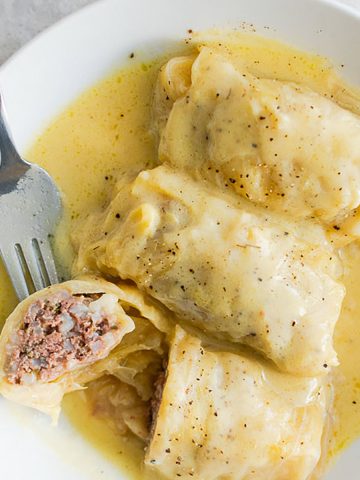
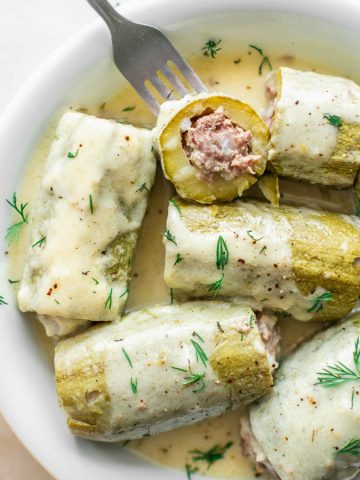
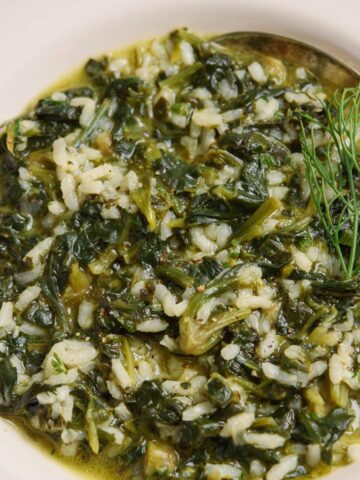
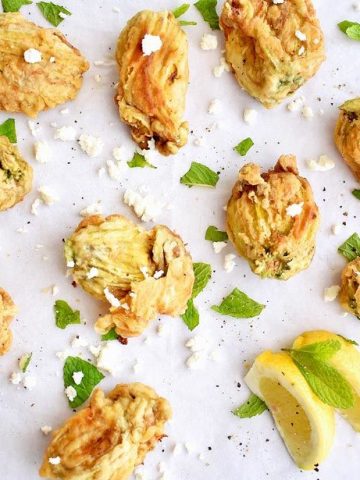
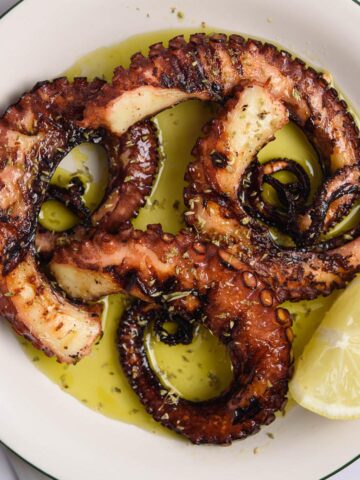
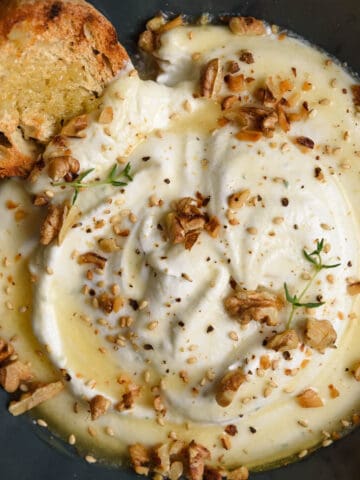
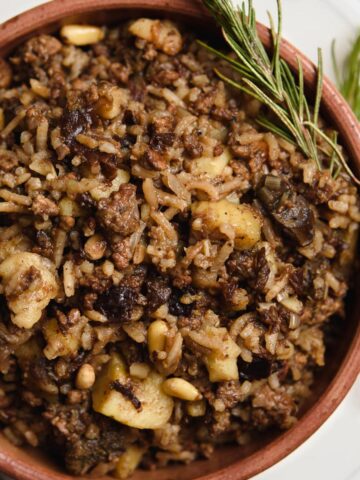
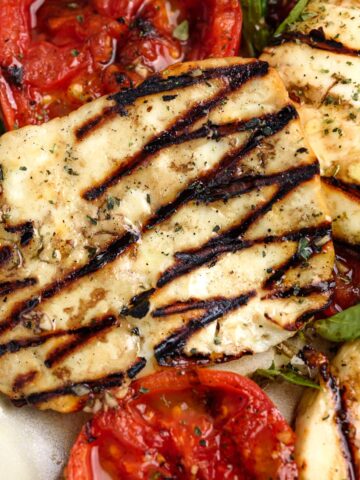
Leave a Reply